
Pickled Carrots and Daikon (Kohaku Namasu)
With a history dating back over 1300 years, Pickled Carrots and Daikon, or Kohaku Namasu (紅白膾) is a Japanese side dish made by quick pickling thin strands of daikon and carrot in vinegar. Because red and white are auspicious colors in Japan, this dish is often eaten as part of the traditional new year's meal, or Osechi Ryori.
My version smoothes over the daikon's funky smell with the fresh zing of citrus zest, and the addition of konbu adds a ton of umami to this easy salad.
Jump to:
Why This Recipe Works
- By salting the carrots and daikon before adding the other seasoning, it draws out excess water from the vegetables. This gives them a nice crunchy texture while preventing them from getting watery
- Bringing the vinegar mixture to a boil with the konbu adds umami to the brine and mellows the vinegar's tartness, keeping the acidity in the Namasu from being too harsh.
- Adding konbu to the pickling liquid releases a natural form of glutamate into it, which gives the pickles the taste of umami.
- A bit of citrus zest such as Meyer lemon or Yuzu added at the end brightens up these carrot and daikon pickles and helps mask the funky smell of the daikon.

Ingredients for Pickled Carrots and Daikon
- Daikon - Daikon(大根), which literally means "large root," is a variety of radish with a large white taproot. When selecting daikon, look for one that's relatively straight and uniform in thickness with smooth taut skin. Because daikon does not age well (it gets stringy and spongy), I recommend looking for one with the greens still attached as this is a good indicator that it is fresh. The greens can also be salted and pickled or minced up and sauteed as a leafy green.
- Carrots - The red color in this red and white pickle comes from carrots. In Japan, we have a variety of carrot called Kintoki Ninjin (金時人参), which is vibrant red in color that is used for this dish. If you're in the US, high-end supermarkets often carry heirloom varieties of carrots, which sometimes includes red carrots. In case you were wondering, the color comes from having a higher beta carotene content than most carrots. If you can't find them, regular carrots will work just fine.
- Salt - I used regular table salt here. If you use a variety with larger flakes, you'll need to increase the amount of salt to account for the air between the flakes.
- Vinegar - The traditional vinegar for Namasu is rice vinegar; however, this will work with apple cider vinegar or even white vinegar. I would recommend avoiding darker varieties of vinegar like balsamic or black vinegar as these will affect the daikon's color.
- Sugar - Like most Asian cuisines, Japanese food is about the balance between savory, salty, sweet, and sour, so the sugar here balances out the acidity of the vinegar and the salt. I've used white sugar here because unrefined sugar will turn the daikon brown, but if you don't use white sugar and don't mind the color, any sugar will work here.
- Konbu - Konbu is kelp, and when dried, it contains a high concentration of the anionic form of glutamic acid. This is a compound that triggers the umami taste receptors in your mouth and is what gives these pickles their savory taste.
- Citrus - Daikon can have a funky, musty smell, and when combined with the fermented smell of vinegar, it can be unpleasant for some. That's why I like to add some citrus zest to this. I used yuzu zest, but Meyer lemon (or regular lemon) zest will work great as well.
How to cut the Carrots and Daikon
The direction you cut root vegetables like carrots and daikon affects their texture. This is because they have fibers running through them from end to end. If you cut against the grain of the fibers, it makes the vegetable softer, whereas if you cut with them, it makes it more firm and crunchy. Since we're turning this into a salad, we want to cut with the direction of the fibers to get the best texture.
To do this, I cut the vegetable into a length that's easy to work with (2-3-inches).

Then I cut a few slices off one side of the vegetable to make a flat spot. By rolling this to the bottom, it keeps the veggie stable. Now you can continue slicing it without having it roll all over the place.
Now you need to line up all of the slices, so they're going in one direction. If you want to be precise, it's best to make several stacks and cut each one separately, but I usually line them up in one staggered stack to make things a little faster.

Now you can julienne them into sticks.
How to Make Pickled Carrots and Daikon (Namasu)
Once you have your veggies cut, you want to sprinkle the salt on top of them and mix it together to distribute the salt evenly. This draws excess water out of the vegetables, which not only makes them more crunchy, it also prevents the pickling liquid from getting watered down later.
While you're waiting for the salt to do its thing, add the vinegar, sugar, and konbu to a stainless steel (or other non-reactive material) pan and bring it to a boil. This not only dissolves the sugar, but it also allows some of the acetic acid in the vinegar to evaporate, giving it a milder taste that's not so sharp. Remove the pan from the heat, and let it cool down, so it doesn't cook the vegetables. When it's cooled off, you can remove the konbu.
Once the vinegar mixture has cooled, drain off all of the excess liquid from the veggies (you don't need to squeeze them out).
Pour the cooled vinegar mixture into the carrots and daikon.
Zest some citrus zest onto it and stir the pickled carrots and daikon together.
If you're packing this into Osechi Ryori, you can serve Kohaku Namasu in a carved out flat-bottomed citrus, like yuzu or a mandarin for impact, or just put it in a nice bowl.

Other Osechi Recipes & Articles
- Datemaki
- Ozoni
- Osechi Ryori (Japanese New Year's Meal)
FAQ
The term Namasu was originally used to refer to meat or fish that had been lacto-fermented with vegetables to make it sour and preserve it. Around 700 years ago, it started to be made with vinegar. These days Namasu is only made with vegetables, and the most common variety is Kohaku Namasu, which is made with carrots and daikon.
Kohaku (紅白) literally means red and white, and the combination symbolizes good luck in Japanese culture. Also, the strands of carrots and daikon are said to look like Mizuhiki (水引), which are charms made from red and white cord tied into decorative knots. These are often used to seal envelopes presented at auspicious occasions and are said to ward off bad spirits while tying people together through a common bond. These, combined with the fact that food prepared for Osechi needs to last for a few days (before the era of refrigeration), makes the inclusion of Kohaku Namasu in Osechi Ryori a no-brainer.
Although there are slight differences in the ingredients (like the type of vinegar), Vietnamese Đồ Chua and Japanese Namasu are very similar dishes. I couldn't find any references to a shared history, so these two dishes were likely created independently. Super interesting if you think about it.
Everything in this recipe is plant-based, however, I have seen some recipes for the Vietnamese version include fish sauce, so if you are ordering it at a restaurant, be careful.
Pickled carrots and daikon will last for at least a week when stored in the refrigerator. While it's hard to give a maximum, I've had Namasu in the fridge for as long as two weeks, and it's been fine.
In Japan, pickles are usually eaten with rice, but Namasu works well on its own or as an accompaniment to other foods, making it more like a salad in Japanese cuisine. Its high acidity and sweetness make for a great palette cleanser to accompany oily or salty dishes like grilled fish or braised meat. I also like putting it into sandwiches like Banh Mi.
📖 Recipe

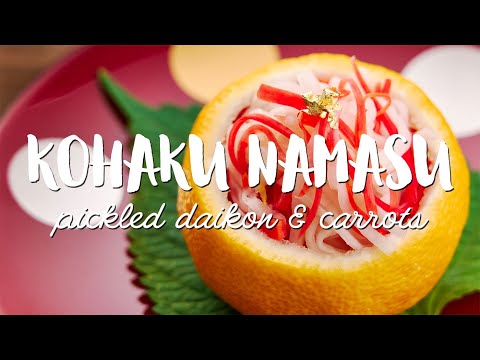
Units
Ingredients
- 450 grams daikon
- 50 grams carrot (I used a red carrot)
- 1 teaspoon salt
- ½ cup vinegar
- 2 tablespoons evaporated cane sugar
- 2 grams konbu (1-inch square)
- Yuzu (or Meyer lemon)
Instructions
- Julienne the carrots and daikon. How you cut them affects the pickles' texture, so see the section on cutting root vegetables in the headnotes above.
- Sprinkle the daikon and carrots with the salt and toss to distribute evenly. Set this aside for at least 15 minutes to allow the excess water to come out of the vegetables.

- Add the vinegar, sugar, and konbu to a small non-reactive saucepan and bring the mixture to a boil. Turn off the heat and let it cool down to room temperature. Leave the konbu in the vinegar until it has cooled, and then remove and discard.

- When the carrots and daikon are limp, drain off all of the excess liquid from the vegetables and add the cooled vinegar mixture. Stir to combine.

- Grate some yuzu zest into the Namasu. This can be served immediately but will keep for up to a week in the refrigerator.


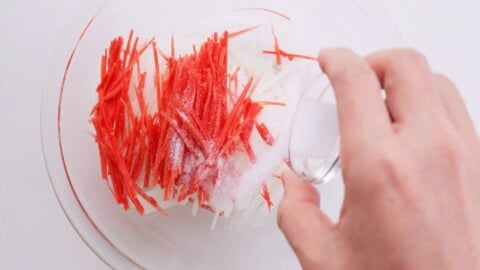
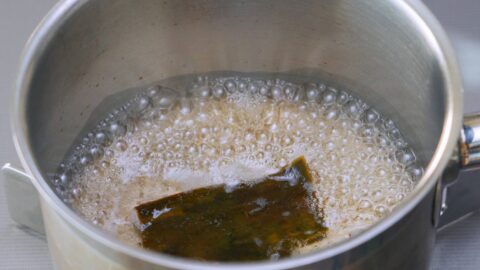
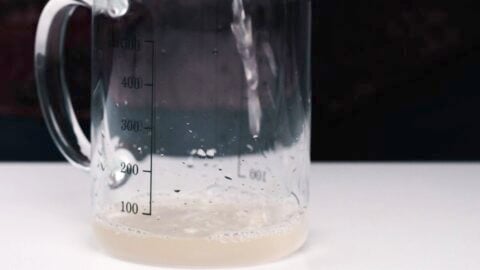
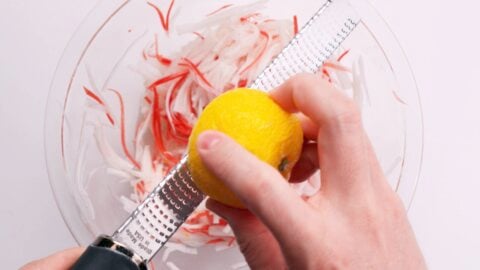
Lynne says
In reading the narrative before the actual recipe, I found this statement:
Once the vinegar mixture has cooled, drain off all of the excess liquid from it (you don't need to squeeze it out).
Im guessing there's something missing that you might want to fix.
Marc says
Hi Lynne, the draining is for the veggies. Sorry this is not clear the way it was written. I've updated.
Irene says
Hello Marc,
I'm wondering what Konbu is. Please explain and let me where I may purchase.
Thanks,
Merry Christmas & Happy New Year.
Marc Matsumoto says
Hi Irene, I explain about konbu in the headnotes. You should be able to find it at any Japanese grocery store, or check online if you don't have one near you.
MARY G says
A type of seaweed. If you have a Japanese grocery store near you, you should be able to find it there. Wakame, another type of seaweed that could be substituted? Kombu is thicker though. They have seaweed in Chinese, Korean , probably all Asian stores but they would have a different name.
Marc Matsumoto says
Hi Mary, thanks for the suggestion. While konbu and wakame are both sea vegetables, this is like comparing tomatoes to potatoes. Konbu has a high concentration of glutamate which is why it is used to make dashi (wakame does not). I've added konbu to this recipe for its glutamate content to give the dressing umami. Adding wakame (or any other commercially available seaweed) would not have the same effect.
Dika Fei says
Hi Irene, konbu is a kind of algae/kelp that when boiled to can contribute a ton of Umami to the stock. Not sure where to find it but usually Asian and especially Japanese supermarket do have it.
Marc might have more info, I'm just a visitor to the site too :).